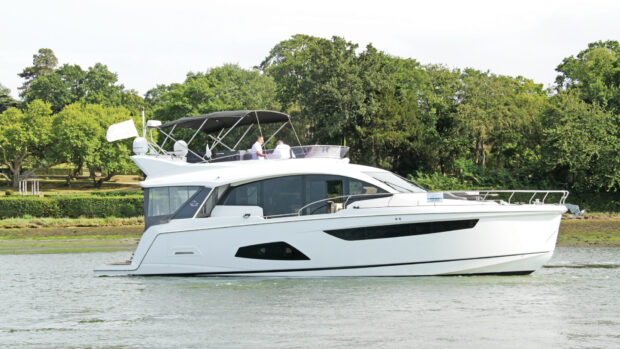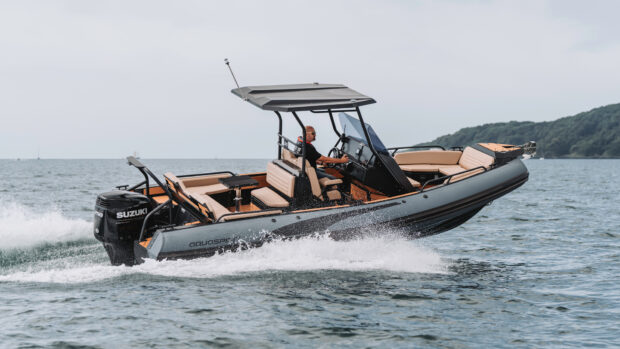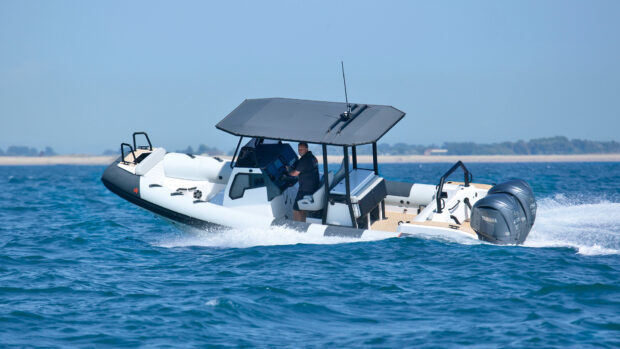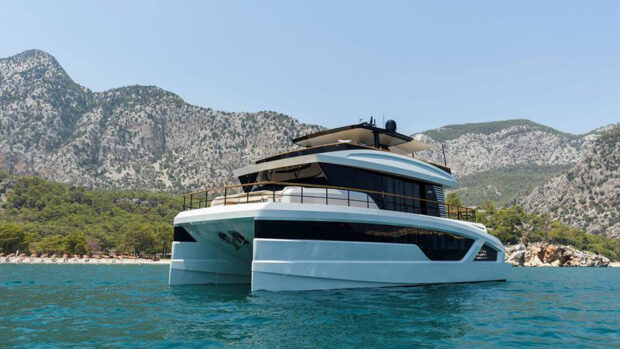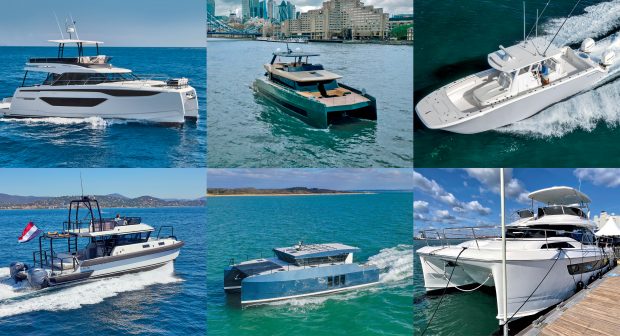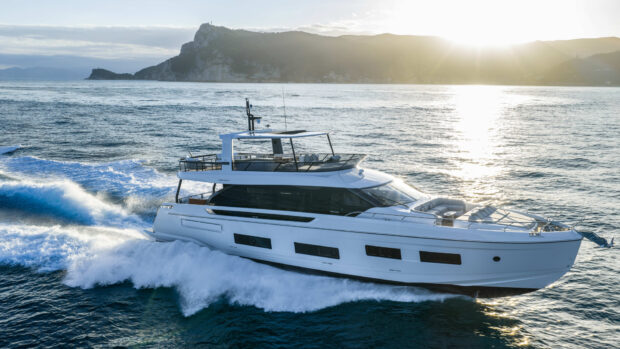Alex Smith heads for Oslo to test the latest, and possibly the greatest, Nordkapp Enduro yet – the Nordkapp Enduro 830
Ever since its foundation in 1966 in the historic Viking town of Sarpsborg in Norway, Nordkapp has been known for its compact, high-quality family powerboats. It wasn’t until the 1990s though, and the beginning of the firm’s association with celebrated Norwegian designer, Espen Thorup, that we really saw Nordkapp’s famous practicality spiked with a healthy extra dose of playfulness and dynamism.
The emergence of the new Enduro centre console and Avant bow rider models saw a marked shift toward sharper, more progressive designs and more capable deep-vee hulls – and today, in line with Nordkapp’s enduring 30-year collaboration with Thorup, those same happy traits endure in the modern fleet.
Whether you’re looking at the open Avant bow riders, the Enduro centre console day boats, the Noblesse sporting weekenders, the Coupé pilothouse cruisers or the high-performance Airborne RIBs, each and every one of Nordkapp’s 17 models is an outboard-powered platform of between 6 and 9m.
Very few builders in the modern market can claim to be quite as focused as that. And that makes it all the more remarkable that, after 60 years of building small boats, this famously restrained builder should describe this new flagship of the Enduro line as its “most versatile vessel ever.”
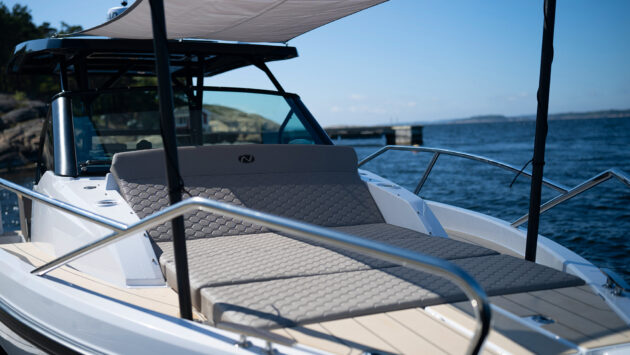
It’s not a huge foredeck but it’s about as cleverly arranged as anything of its size
Bigger and smarter
The first element of that versatility is its size. The Nordkapp Enduro 830 might be a 27ft boat but with its 9ft 7in beam, it’s a foot longer and a massive 1ft 3in wider than the next model down. In fact, there’s such a clear difference between the scale and purpose of this and the Nordkapp Enduro 805 that, in spite of their nominally similar lengths, both boats will continue to be built concurrently.
As for the way that beam is used, that’s where Thorup is able to really show off what he can do. Generous side decks wrap all the way around this boat in tandem with a whole assortment of well-placed grab rails. But there’s still room in the aft part of the cockpit for a central C-shaped sofa with a table and a clever set of backrests.
The aft one slides, enabling you to face forward or aft (or both); and if you drop the table infill into the gap and fold out the lateral backrests, you can create a full-beam sunbed as large as any you are likely to see on an 8m monohull.

The slide-out fridge remains an option, even if you go for a central seat instead of a wet bar
The details are excellent too. You can leave one of the backrests up to retain access fore and aft. There are neat wooden linings on the top edges of the backrests to take the weight when you ease them down onto the bulwarks’ fibreglass lips.
There’s masses of storage beneath the aft bench in a cabinet made all the more usable thanks to a really rugged fabric liner. And there are glass panels built into the tops of the bulwarks to help keep the cockpit secure without restricting the view out.
You could, in principle, opt to lose the dinette’s side pods and open up this section of the deck for extra space but, given that the test boat features the optional wet bar behind the helm seats (rather than a simple aft-facing bench), it makes little sense to lose the side seats too.
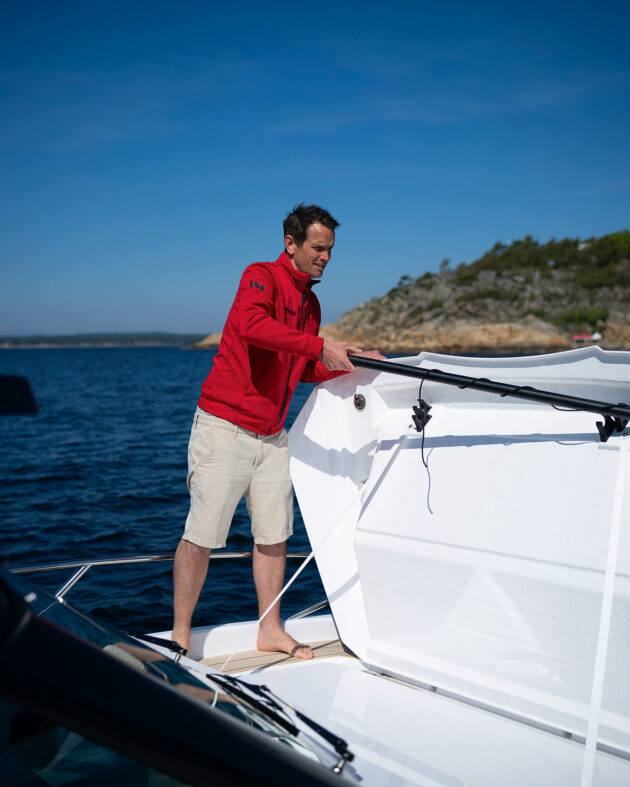
The bow’s sunbed backrest hinges aft for easy stowage of lines, fenders, poles and canvases
Brilliant bow
As you head forward, along those side decks, past neat bulwark recesses for as many as three fenders on either side, you find yourself on a remarkably flat and quite sparse-feeling foredeck. But this part of the boat is arguably even slicker than the cockpit.
A pair of fibreglass fingers projects out from beneath the screen, neatly book-ending the sloping backrest for a two-person sun lounger. These mouldings keep you really secure and comfy on the sunbed – and when you hinge the unit forwards, there’s a very handy storage space for your sunshade canvas and struts.
Better still, the sunbed’s cushioned base comprises three connected sections. Their leading edge straps down to poppers in the anchor locker so they’re super-secure underway. And when it’s time to put the cushions to bed, you simply concertina them up into the fibreglass alcove, revealing a canvas on the deck that wraps over the top and poppers into place.
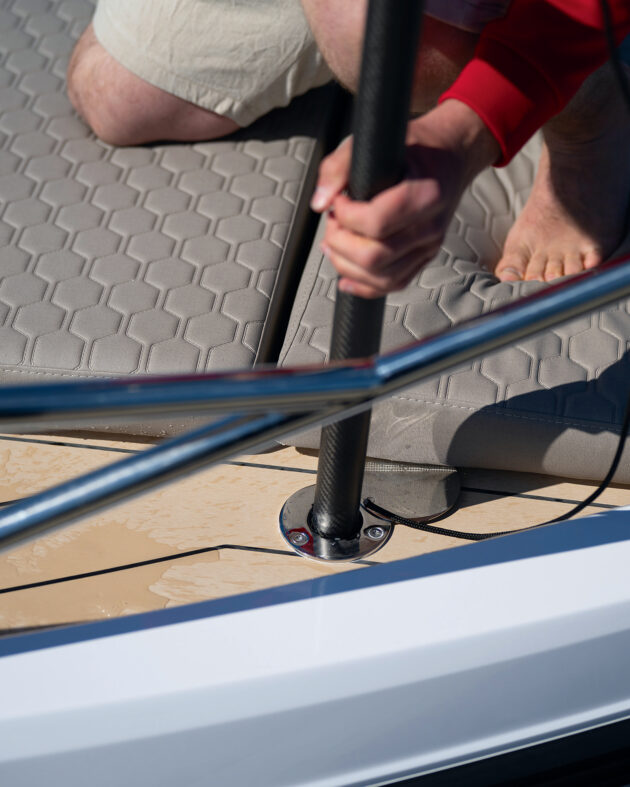
You can use the poles and canvases from beneath the sunbed backrest for a quick and simple sunshade
It takes less than 15 seconds to complete the entire job – and when you’re about to head out to sea, or you’re keen to head home after a long day on the water, that kind of simplicity can often feel blissfully satisfying.
We won’t harp on about the bow space much longer but even the bow locker is a treat. It conceals a dedicated gas box beneath the starboard hatch and a chain locker to port. The port cabinet also contains the water filler, which, like the transom’s fuel filler, is perfectly positioned for easy drainage of any overspill – and there’s even some netting in here to keep your lines dry and fresh.
These are small things, admittedly, but taken in their entirety, they make this one the very best foredeck solutions we’ve ever seen on a tapered sports boat of such modest dimensions. And yet the versatility of this boat is also tied into the roof design…
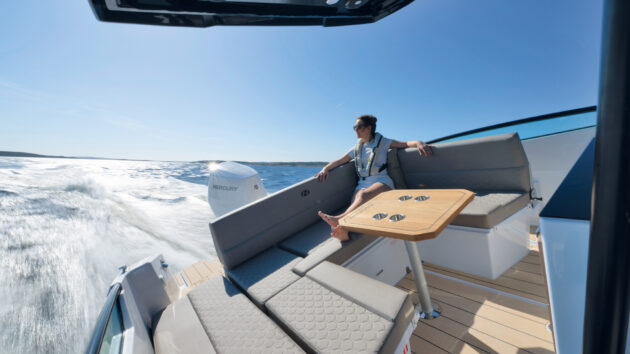
The security and versatility of the cockpit are just as impressive as the agility of the drive
You can basically have it entirely open; open with a sprayhood; with the T-Top; or with the T-Top and the canopies. Our test boat uses the last of these and what’s particularly good is the fact that the canopy design takes advantage of the fulsome beam, strapping down to the deck toward the centre of those broad peripheral walkways.
That means you can fully enclose the helm and cockpit and enjoy the diesel heating for year-round comfort much as you would on a sporting coupé, while still making your way fore and aft without obstruction whether you’re on the inside or the outside of those closed canopies.
The benefits of that for an extended season in northern Europe are very clear but this solution is equally positive in terms of the 830’s relevance on the broader international market.
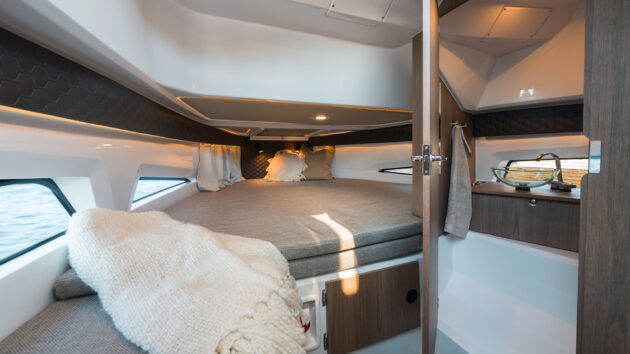
Sleep with your head aft for extra space, extra light and better views
Easy-access entertainment
As we ease out of the marina beneath a spring sun, it takes no time at all to feel at one with the skipper’s position. The fact that there’s a pair of 12in plotters on the upper tier of the dash is pretty standard. But what’s really pleasing is the very conscious priority ordering of the touch points.
The really critical kit, like your tabs and your wiper button, are located directly next to the throttle. On the left-hand side comes an upper tier of intermediate switchgear. And the ‘probably-need-it-but- never-likely-to-use it’ stuff is relegated to the lower level, out of sight with your gym card, your angostura bitters and your jar full of obsolete currencies.
As for the drive, although Espen believes this prototype model is a shade bow-heavy, we can perceive none of that at all. It’s really well behaved off the plane and when you push it through the all-but-imperceptible hump, it delivers the utmost predictability in terms of the way it responds to your input at the helm.
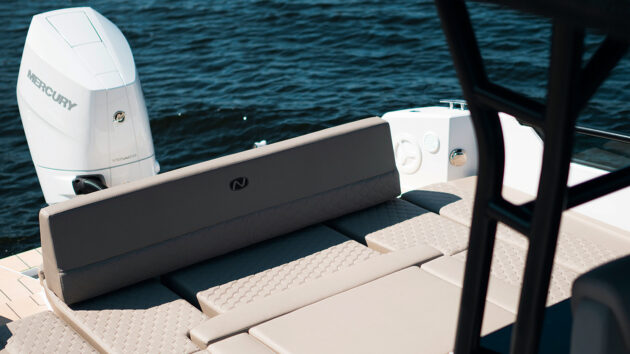
A full-beam sunbed with an aft-facing bench seat – just one of the many ways you can rig the dinette
Whether you’re flying along at close to 50 knots or carving a hard turn, there’s brilliant control and lovely natural trim from that deep-vee non-stepped hull. If you want to ramp things up, twin 250s will apparently bring you around 52 knots at the top end and, if that’s what Nordkapp is claiming, you can probably expect a little bit more.
However, as the third model to use the 830 hull, this is a proper performance boat that even a complete novice can enjoy right from day one. To put that statement in a more revealing perspective (because that’s what you have to do with boats that perform beyond regular expectations), you couldn’t say it has quite the same order of fizz and focus as a lightweight specialist driving machine like the Iron Boats 827 or the XO DFNDR 8. But as fast, spacious, multi-function weekenders go, the performance of the new Enduro 830 is absolutely first class.
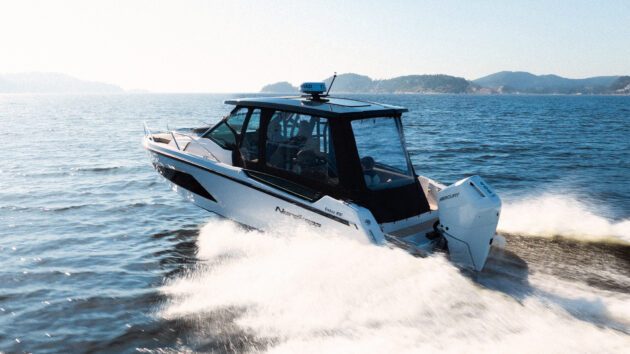
The canopy option is really practical
Almost forgot…
Buoyed by the calibre of the style, the detailing, the flexibility and the drive, we’re about to sign off and stroll into the sunset, when we remember there’s a cabin we ought to take a look at. It’s not a proper cruising cabin of course; more a traditional cuddy with a double bed, a compact heads compartment and a changing seat. But it’s perfectly decent.
The bed is well sized and if you sleep with your head aft, you get extra headroom, extra breadth and uprated views through the deeper sections of hull window. The starboard heads compartment, meanwhile, is compact and functional but, with a moulding for a deck drain and sufficient deck height to conceal a pump, it seems certain that subsequent production models will provide the option of a shower.
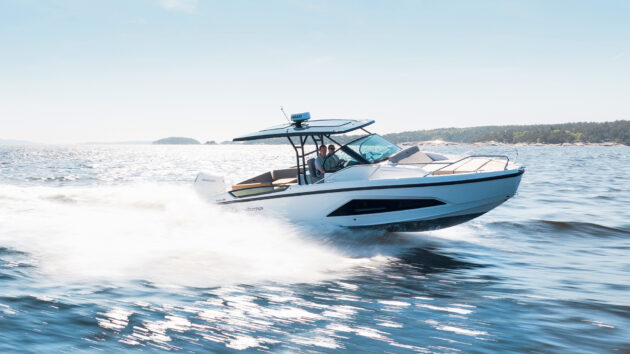
Whether you’re piling on the pace or carving hard, there’s great control from the 830’s non-stepped hull
As for that changing seat, you might even argue that it could be used as part of an occasional single bed, thanks to a storage space that projects aft beneath the external port deck. But rather than stretch credulity too far, we’ll simply say that, as a snoozing spot for a weekend away or a changing zone for a day out, it does an entirely adequate job.
Nordkapp Enduro 830 specifications
LOA: 27ft 3in (8.30m)
BEAM: 9ft 7in (2.92m)
DRAFT: 1ft 11in (0.58m)
DISPLACEMENT: 2,560kg (light)
FUEL CAPACITY: 340 litres
WATER CAPACITY: 43 litres
ENGINES: 1 x 300-400hp / 2 x 200-250hp outboards
RCD: C10
CONTACT: nordkapp-boats.com
Nordkapp Enduro 830 costs & options
From: €124,400 ex VAT. Test boat includes:
Mercury V10 400: €11,200
Highline+ package: €18,570
Webasto ATE2000 heating system: €3,960
Pantry with cooker: €3,760
Aft side benches with folding backrests: €2,460
 If you enjoyed this….
If you enjoyed this….
Motor Boat & Yachting is the world’s leading magazine for Motoryacht enthusiasts. Every month we have inspirational adventures and practical features to help you realise your sailing dreams, as well as tests and news of all the latest motorboats.
Plus you’ll get our quarterly Custom Yachting supplement where we share the last on offer in the superyacht world and at the luxury end of the market.
Build your knowledge with a subscription delivered to your door. See our latest offers and save at least 30% off the cover price.
Note: We may earn a commission when you buy through links on our site, at no extra cost to you. This doesn’t affect our editorial independence.
Verdict
The Enduro 830 is a great looking boat with plenty of clever thinking in the layout, excellent flexibility in terms of potential applications and a really fine drive. Even as boat number one, virtually every detail resonates with design intelligence, and if the sensible pricing and clever options list don’t seal the deal, then the likelihood of strong residual values makes it all the more attractive. As for the negatives, you might muse on whether it’s actually too good looking to remain good looking in ten years; whether it might be better off adopting a plain and classical aesthetic that never gets old cos it never felt new. But realistically, there’s not a lot to criticise. If you want a fast, open, cuddy-style family sportsboat that feels great and does a little more, this is a bit of a gem.
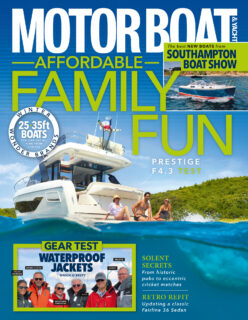


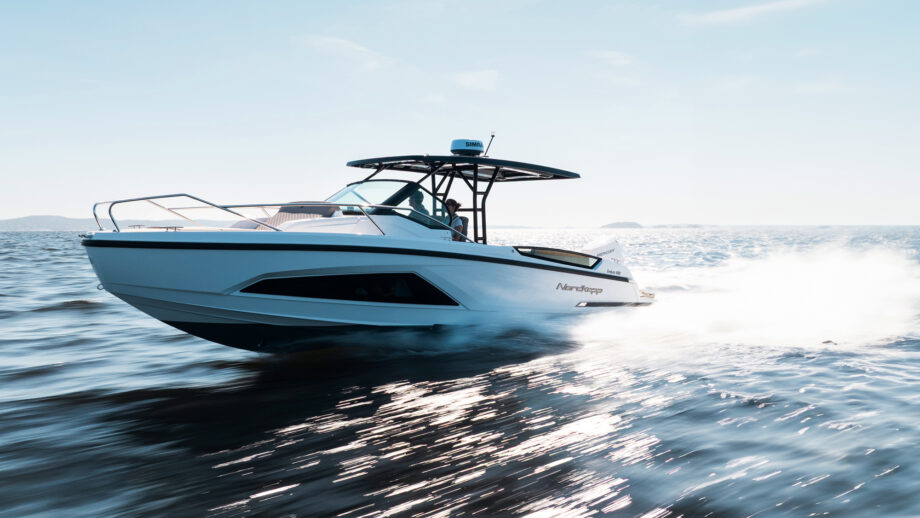
 If you enjoyed this….
If you enjoyed this….